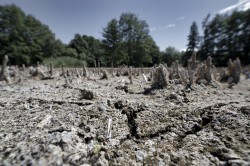Press Release, 04. February 2021
Shorter but more intense
Changes in the European droughts
Drought periods in Europe are shorter but more intense since the beginning of the 20th century. Moreover high temperatures, often accompanying these droughts, cause greater water loss from the soil. This has a significant negative effect on agriculture and vegetation in general. This is the result made by an international team of scientists with the participation of the Helmholtz Centre for Environmental Research (UFZ) in a study released in Science Advances.
"These extremes are manifested especially in the warm (vegetation) part of the year. In addition, they have prevailed in the last two decades. Landscape management will have to respond to these changes," said the study's lead author, Dr. Yannis Markonis from the Czech University of Life Sciences in Prague (CULS).
Researchers have used machine learning algorithms and hydrological model simulations to detect changes in the characteristics of drought since the early 20th century. It turned out that for most of Europe there was a significant increase in relatively short episodes of drought during the warm half of the year (so-called summer droughts) accompanied by high temperatures. "Shorter summer droughts are gradually playing an increasingly important role, replacing less intense and longer ones. What we are often seeing, especially in the last twenty years, is the increase of such droughts especially in Central Europe" added co-author and UFZ hydrologist Dr. Rohini Kumar.
During the summer droughts, experts note a sharper decline in soil water supplies, which results in more severe impacts on agriculture and vegetation in general. "If the fraction of summer droughts in Europe continues to grow, we can expect an increase in demands on water resources for agriculture, changes in the structure and dynamics of vegetation and an increase in the risk of natural fires. These changes should be taken into account when proposing measures to mitigate the risk of hydroclimatic extremes in the future," added Prof. Martin Hanel the head of the Hydrological & Climate variability research group at the Faculty of Environment Sciences CULS.
The research work of the UFZ scientists involved was carried out within the bilateral project XEROS (eXtreme EuRopean drOughtS: multimodel synthesis of past, present and future events) and funded by the German Research Foundation and the Czech Science Foundation.
Publication:
Y. Markonis, R. Kumar, M. Hanel, O. Rakovec, P. Maca, A. AghaKouchak, The rise of compound warm-season droughts in Europe. Sci. Adv. 7, eabb9668 (2021). https://doi.org/10.1126/sciadv.abb9668
Further information
Prof. Martin Hanel
Czech University of Life Sciences Prague
hanel@fzp.czu.cz
Dr. Yannis Markonis
Czech University of Life Sciences Prague
markonis@fzp.czu.cz
Dr. Rohini Kumar
UFZ Department Computational Hydrosystems
rohini.kumar@ufz.de
UFZ press office
Susanne Hufe
Phone: +49 341 6025-1630
presse@ufz.de
In the Helmholtz Centre for Environmental Research (UFZ), scientists conduct research into the causes and consequences of far-reaching environmental changes. Their areas of study cover water resources, ecosystems of the future, environmental technologies and biotechnologies, the effects of chemicals in the environment, modelling and social-scientific issues. The UFZ employs more than 1,100 staff at its sites in Leipzig, Halle and Magdeburg. It is funded by the Federal Government, Saxony and Saxony-Anhalt.
www.ufz.deThe Helmholtz Association contributes to solving major challenges facing society, science and the economy with top scientific achievements in six research fields: Energy; Earth and Environment; Health; Key Technologies; Matter; and Aeronautics, Space and Transport. With some 39,000 employees in 19 research centres, the Helmholtz Association is Germany’s largest scientific organisation.
www.helmholtz.de
